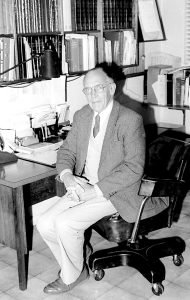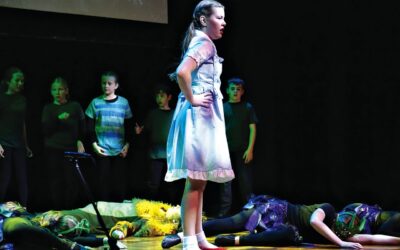Gunnedah has always been gifted with dedicated, professional doctors who were often regarded as family friends rather than medicos.
In the post war era right up until the 1990s, young doctors came to Gunnedah and settled to raise their families.
Much has been written about Dr Colin Anderson who became somewhat of a local legend, with his trademark jar of jellybeans making him a hit with his young patients.

Dr Anderson during wartime.
He came to Gunnedah in 1919, to begin his practice after serving in the battlefields of Europe. When he arrived, Gunnedah’s population was 3000 and the town was being serviced by an Italian, Dr Guiseppe Riolo, and an Englishman Dr May.
Dr Colin Anderson had an enormous influence on community life in Gunnedah over a period of more than 60 years. He retired in 1962, when Dr Frank Byrnes joined the practice, but continued to serve the community as Government Medical Officer.
His death at Gunnedah in 1982 at the age of 91 saddened a wide cross-section of the community who had come to love and admire the man who delivered more than 3000 of the town’s babies.
Looking back to an era before ‘Doc Andy’ as he was affectionately known, the first resident doctor in Gunnedah was a Dr Chapin who set up a practice in 1859 just three years after the settlement was proclaimed a town. He was followed by Doctors Riley and Eegol in the 1860s and Dr Richards in the 1870s.
The opening of the railway to Gunnedah in 1879 gave new life to the sleepy community and with it came the impetus for a district hospital, which opened in 1882.
A Dr Dalton had settled in Gunnedah the previous year and he was to give the community 12 years of dedicated service, often having to contend with the dreaded diseases of diphtheria and typhoid.
Other doctors to serve Gunnedah from 1880 were Doctors SA Dowe, Tynan, Madden, Carr and Dr DB Canney (who died after being thrown from a horse in Conadilly Street). Doctors Middleton, Haynes, Griffiths, Massey, EG Horton and A. Miers also practised during this period.
Dr Herbert Lee came to Gunnedah in 1893 and took over the practice of Dr Dalton. He was the son-in-law of Police magistrate and coroner for Gunnedah, Patrick Brougham. Dr Lee left for England to further his studies in 1905.
Dr Crooke and Dr G. McLean formed a partnership to take over Dr Lee’s practice. The first motorcyle in Gunnedah was used by Dr McLean.
Other doctors to practise in the town from 1905 to 1920 were Drs MA Gibbs, G. Chipperfield, FL Keith, C. Shellshear, H. Turkington and G. Riolo – who ran his practice on the corner of Elgin Street and Little Barber Lane – E. Culpin, Tasman Wilson, F. Tipping, GB Lindeman, CA Crothers, FH May, BM Beith, whose surgery was on the corner of Abbott and Barber Streets, and Dr HM Kennedy.
From 1924 the doctors listed as practising in Gunnedah were PH Stanley, SG Iceton, J. English, L. Charlton, G. Clifton- Smith, FJ Musso and Dr R. O’Kane, who bought Dr Iceton’s practice at 59 Barber Street.
During the difficult war years Dr Stanley and Dr Anderson were the only two medical officers left in the town and district.

Dr Peter Stanley.
In 1948 Dr Arthur Lundie bought Dr Charlton’s practice in Conadilly Street and seven years later built the first individual surgery at 88 Marquis Street, at a cost of 4000 pounds.
Until this time doctors’ surgeries had been part of their residences.
Dr Lundie died in 1998, after maintaining his daily ritual of seeing his patients right up until his death at 81 years.
Gunnedah Nursing Home was renamed Lundie House as a testament to his wonderful service.
Dedicated doctors to follow Dr Lundie into practice were Dr Roger Edwards and Dr Bob Pilcher, with Dr Donald Barr joining Dr Anderson’s practice in 1954. Dr Barr gained a reputation as a kind, gentle and dedicated GP during his many years of practice in Gunnedah.
Dr Harris came to Gunnedah in 1964 to take over from Dr Byrnes. He served the community for 37 years before retiring to Sydney in 2001.
In 1964 Dr Barr and Dr Harris moved from Dr Anderson’s residence to a new surgery at 83 Marquis Street.
By 1975 Dr Lundie’s practice had expanded to include Dr Rod Jones, Dr Jim Laurence, Dr David Cooke and Dr Grahame Deane, with Dr John Adams joining Dr Barr and Dr Harris the following year. Dr Deane, Dr Susan Paul and her husband Dr David Young formed a practice in 1986, with a new surgery constructed in Barber Street.
Dr Martin Wainberg came to Gunnedah in 1988 and by 1992, Dr David Learoyd, Dr Rod Jones, Dr Rob Parsons and Dr Brian Bickerton were also practising in the town.
Parsons, Dr Andrew Lam, Dr Maisie Dong, Dr Chris Gittoes, Dr Brian Bickerton, Dr Richard Thornton, Dr Paul Wood. Dr Parsons and Dr Gittoes remain in practice in Gunnedah with a number of new doctors arriving in recent years to practice at the three surgeries.
Doctor Peter Stanley:
Dr Percival Hubert (Peter) Stanley came to Gunnedah in 1924 and set up a practice in Conadilly Street, over the years becoming a very prominent citizen.
In 1926, he purchased Numalong from the estate of Josephine Turner. At the time the private hospital was being conducted by Sr Agnes Melvil Mason.
During the difficult war years Dr Stanley and Dr Colin Anderson were the only two medical officers left in the town and district.
With the Gunnedah District Hospital on the southern side of the railway gates, local doctors often encountered difficulty getting to the hospital in an emergency when the crossing gates were closed.
In 1932, Dr Stanley decided to stand for council with the express purpose of pressing the case for an overhead bridge in Abbott Street.
Local doctors were concerned at the delays, with the ambulances often having to wait at the crossing during emergencies and doctors having to clamber over the gates, dodge the train and then walk or run to the hospital, sometimes late at night.
Plans for a bridge were first mooted in 1903 but it was to be almost another decade after his election to council that Dr Stanley succeeded in his efforts, with the bridge officially opened on September 20, 1941. Several years ago, the overhead bridge was named in his honour. Dr Stanley served a term as mayor from 1939-40 and retired from council in 1941.
He left Gunnedah in 1947 after selling his practice to Dr Arthur Lundie. Numalong was taken over by Sr Elsie Phillips who had joined the staff in 1935.
Dr Arthur Lundie:

Dr Arthur Lundie.
When Dr Arthur James Lundie died at Gunnedah Hospital, on November 6, 1998, he left behind a legacy of dedication, commitment and compassion to the community he served for 50 years.
It was wartime when Arthur Lundie completed his basic medical degree and signed up for the RAAF. Although posted to a medical unit, Flight Lieutenant Lundie also gained his “wings” as a pilot and saw service in the Borneo campaign of 1945.
In 1949 Dr Lundie bought Dr Stanley’s practice in Conadilly Street and seven years later built the first individual surgery at 88 Marquis Street, at a cost of 4000 pounds. Until this time doctors’ surgeries had been part of their residences. Other doctors and businesses soon made this new development a prominent part of town.
Over the next few decades, Dr Lundie served the community with great dedication, underpinned by his Christian faith and his creed as a doctor.
An eventful era in Dr Lundie’s practice was an outbreak of a particularly virulent form of poliomyelitis, which resulted in long queues of residents seeking protection through the newly-released Salk vaccine.
When Gunnedah’s long-awaited nursing home finally came to fruition in June 1990, Dr Lundie was invited to unveil the foundation stone.
In 2003 Gunnedah Nursing Home was later re-named Lundie House to honour the commitment and dedication of Dr Lundie to the facility.
Five months before his death, Arthur Lundie was awarded the inaugural Service Above Self Award, by the Rotary Club of Gunnedah, in recognition of his outstanding contribution to the community. Dr Lundie was described by his colleague Dr David Cooke as a classic family doctor, a mentor and medical inspiration.
Until his death at the age of 81, Dr Lundie maintained a ritual of being at his surgery each weekday morning to see his patients.
Dr Lundie’s kindness, compassion and sincerity left a deep impression on everyone who had any contact with him and his death was greeted with sadness. Dr Lundie and his wife Betty Gregg (nee Henderson) were married in 1949 and together they raised three children – Jim (Gregg), Robert and Susie.
Dr Bob Pilcher:

Dr Bob Pilcher.
Dr Robert (Bob) Pilcher came to Gunnedah in 1951 and started his own practice the following year after serving in the AIF Medical Corps in the Middle East and New Guinea during World War II.
Born at Potts Point, Sydney, in 1915, he graduated from the University of Sydney in 1939 and was appointed junior resident medical officer at Sydney Hospital. Dr Pilcher brought a wealth of experience to his new practice which often required counselling, mental health, child welfare – and even veterinary skills.
He was also a dedicated member of the community, serving on the Memorial Baths committee and helping to excavate the hole in Anzac Park for the swimming pool.
He was a member of the Anglican Parochial Council and an enthusiastic part of the Gunnedah Musical and Dramatic Society, the Civil Defence (now SES) and the local Citizens’ Military Forces (CMF).
In 1963 he was appointed Government Medical Officer, a position he held until retirement at the age of 70.
Dr Pilcher was a charter member of the Gunnedah Lions and a foundation member of the Rotary Club of Gunnedah West.
He also enjoyed painting, photography, music, amateur radio and cars.
Dr Pilcher and his wife Barbara had four children – a son and daughter who sadly died in infancy and two sons, Bruce and Andrew.
Dr Pilcher retired in May 1985 and was guest of honour at a farewell function attended by colleagues of Gunnedah District Hospital, where he had been a visiting medical officer for 34 years.
To order photos from this page click here



